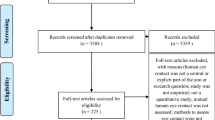Abstract
Attentional biases to and away from threat are considered hallmarks of temperamental behavioral inhibition (BI), which is a documented risk factor for social anxiety disorder. However, most research on affective attentional biases has traditionally been constrained to computer screens, where stimuli often lack ecological validity. Moreover, prior research predominantly focuses on momentary presentations of stimuli, rather than examining how attention may change over the course of prolonged exposure to salient people and objects. Here, in a sample of children oversampled for BI, we used mobile eye-tracking to examine attention to an experimenter wearing a “scary” or novel gorilla mask, as well as attention to the experimenter after mask removal as a recovery from exposure. Conditional growth curve modeling was used to examine how level of BI related to attentional trajectories over the course of the exposure. We found a main effect of BI in the initial exposure to the mask, with a positive association between level of BI and proportion of gaze allocated to the stranger’s masked face over time. Additionally, there was a main effect of BI on proportion of gaze allocated to the stranger’s face plus their mask during the recovery period when the mask was removed.





Similar content being viewed by others
References
Amso, D., & Scerif, G. (2015). The attentive brain: Insights from developmental cognitive neuroscience. Nature Reviews Neuroscience, 16, 606–619. https://doi.org/10.1038/nrn4025
Bishop, G., Spence, S. H., & McDonald, C. (2003). Can parents and teachers provide a reliable and valid report of behavioral inhibition? Child Development, 74(6), 1899–1917.
Broeren, S., & Muris, P. (2009). The relation between cognitive development and anxiety phenomena in children. Journal of Child and Family Studies, 18, 702–709. https://doi.org/10.1007/s10826-009-9276-8
Brooker, R. J., & Buss, K. A. (2010). Dynamic measures of RSA predict distress and regulation in toddlers. Developmental Psychobiology, 52(4), 372–382. https://doi.org/10.1002/dev.20432
Burris, J. L., Barry-Anwar, R. A., & Rivera, S. M. (2017). An eye tracking investigation of attentional biases towards affect in young children. Developmental Psychology, 53(8), 1418–1427. https://doi.org/10.1037/dev0000345
Burris, J. L., Buss, K. A., LoBue V., Pérez-Edgar, K., & Field, A. (2019). Biased attention to threat and anxiety: On taking a developmental approach. Journal of Experimental Psychopathology, 10(3). https://doi.org/10.1177/2043808719860717
Buss, K. A. (2011). Which fearful toddlers should we worry about? Context, fear regulation, and anxiety risk. Developmental Psychology, 47(3), 804–819. https://doi.org/10.1037/a0023227
Buss, K. A., Davis, E. L., Kiel, E. J., Brooker, R. J., Beekman, C., & Early, M. C. (2013). Dysregulated fear predicts social wariness and social anxiety symptoms during kindergarten. Journal of Clinical Child & Adolescent Psychology, 42(5), 603–616. https://doi.org/10.1080/15374416.2013.769170
Chronis-Tuscano, A., Degnan, K. A., Pine, D. S., Pérez-Edgar, K., Henderson, H. A., Diaz, Y., … Fox, N. A. (2009). Stable early maternal report of behavioral inhibition predicts lifetime social anxiety disorder in adolescence. Journal of the American Academy of Child & Adolescent Psychiatry, 48(9), 928-935. https://doi.org/10.1097/CHI.0b013e3181ae09df
Clauss, J. A., & Blackford, J. U. (2012). Behavioral inhibition and risk for developing social anxiety disorder: A meta-analytic study. The Journal of the American Academy of Child and Adolescent Psychiatry, 51(10), 1066–1075. https://doi.org/10.1016/j.jaac.2012.08.002
Datavyu Team. (2014). Datavyu: A video coding tool. Databrary Project, New York University. Retrieved from https://www.datavyu.org.
Franchak, J. M., & Adolph, K. E. (2010). Visually guided navigation: Head-mounted eye-tracking of natural locomotion in children and adults. Vision Research, 50(24), 2766–2774. https://doi.org/10.1016/j.visres.2010.09.024
Franchak, J. M., Kretch, K. S., & Adolph, K. E. (2017). See and be seen: Infant-caregiver social looking during locomotor free play. Developmental Science, 21(4), 1–13. https://doi.org/10.1111/desc.12626
Foulsham, T., & Kingstone, A. (2017). Are fixations in static naturalistic scenes a useful predictor of attention in the real world? Canadian Journal of Experimental Psychology, 71(2), 172–181. https://doi.org/10.1037/cep0000125
Fox, N. A., Henderson, H. A., Marshall, P. J., Nichols, K. E., & Ghera, M. M. (2005). Behavioral inhibition: Linking biology and behavior within a developmental framework. Annual Review of Psychology, 56, 235–262. https://doi.org/10.1146/annurev.psych.55.090902.141532
Fu, X., Taber-Thomas, B. C., & Perez-Edgar, K. (2017). Frontolimbic functioning during threat-related attention: Relations to early behavioral inhibition and anxiety in children. Biological Psychology, 12298–109. https://doi.org/10.1016/j.biopsycho.2015.08.010
Fu, X., Nelson, E. E., Borge, M., Buss, K. A., & Pérez-Edgar, K. (2019). Stationary and ambulatory attention patterns are differentially associated with early temperamental risk for socioemotional problems: Preliminary evidence from a multimodal eye-tracking investigation. Development and Psychopathology, 31, 971–988. https://doi.org/10.1017/S0954579419000427
Fu, X., & Pérez-Edgar, K. (2019). Threat-related attention bias in socioemotional development: A critical review and methodological considerations. Developmental Review, 51, 31–57. https://doi.org/10.1016/j.dr.2018.11.002
Gibb, B. E., McGeary, J. E., & Beevers, C. G. (2015). Attentional biases to emotional stimuli: Key components of the RDoC constructs of sustained threat and loss. American Journal of Medical Genetics Part b: Neuropsychiatric Genetics, 171(1), 65–80.
Goldsmith, H. H., Reilly, J., Lemery, K. S., Longley, S., & Prescott, A. (1995). Laboratory temperament assessment battery: Preschool version. Unpublished manuscript.
Gregory, N. J., Bolderston, H., & Antolin, J. V. (2019). Attention to faces and gaze-following in social anxiety: Preliminary evidence from a naturalistic eye-tracking investigation. Cognition and Emotion, 33(5), 931–942. https://doi.org/10.1080/02699931.2018.1519497
Grossman, R. B., Zane, E., Mertens, J., & Mitchell, T. (2019). Facetime vs. Screentime: Gaze patterns to live and video social stimuli in adolescents with ASD. Nature Scientific Reports, 9. https://doi.org/10.1038/s41598-019-49039-7
Gunther, K. E., Fu, X., MacNeill, L., Vallorani, A., Ermanni, B., & Perez-Edgar, K. (under review). Profiles of naturalistic attentional trajectories moderate the relation between Behavioral Inhibition and internalizing symptoms: a mobile eye tracking study.
Henderson, H. A., & Wilson, M. J. G. (2017). Attention Processes Underlying Risk and Resilience in Behaviorally Inhibited Children. Current Behavioral Neuroscience Reports, 4, 99–106. https://doi.org/10.1007/s40473-017-0111-z
Heuer, K., Rinck, M., & Becker, E. S. (2007). Avoidance of emotional facial expressions in social anxiety: The Approach-Avoidance Task. Behaviour Research and Therapy, 45(12), 2990–3001. https://doi.org/10.1016/j.brat.2007.08.010
Hirshfeld, D. R., Rosenbaum, J. F., Biederman, J., Bolduc, E. A., Faraone, S. V., Snidman, N., Reznick, J. S., & Kagan, J. (1992). Stable behavioral inhibition and its association with anxiety disorder. Journal of the American Academy of Child & Adolescent Psychiatry, 31(1), 103–111. https://doi.org/10.1097/00004583-199201000-00016
Kagan, J., Reznick, J. S., & Snidman, N. (1987). Biological bases of childhood shyness. Science, 240(4849), 167–171. https://doi.org/10.1126/science.3353713
Kashdan, T. B., Goodman, F. R., Machell, K. A., Kleinman, E. M., Monfort, S. S., Ciarrochi, J., & Nezlek, J. B. (2014). A contextual approach to experiential avoidance and social anxiety: Evidence from and experimental interaction and daily interactions of people with social anxiety disorder. Emotion, 14(4), 769–781.
Kassner, M., Patera, W., & Bulling, A. (2014). Pupil: An open source platform for pervasive eye tracking and mobile gaze-based interaction. In Proceedings from the 2014 ACM International Joint Conference of Pervasive and Ubiquitous Computing: Adjunct Publication (pp. 1151-1160). Seattle, Washington: ACM.
Kretch, K. S., & Adolph, K. E. (2015). Active viewing in passive locomotion: Real-world free viewing in infants and adults. Developmental Science, 18(5), 736–750. https://doi.org/10.1111/desc.12251
Kretch, K. S., Franchak, J. M., & Adolph, K. E. (2014). Crawling and walking infants see the world differently. Child Development, 85(4), 1503–1518. https://doi.org/10.1111/cdev.12206
Ladouce, S., Donaldson, D. I., Dudchenko, P. A., & Ietswaart, M. (2017). Understanding minds in real-world environments: Toward a mobile cognition approach. Frontiers in Human Neuroscience, 10(684), 1–14. https://doi.org/10.3389/fnhum.2016.00694
Lonigan, C. J., Vasey, M. W., Phillips, B. M., & Hazen, R. A. (2004). Temperament, anxiety, and the processing of threat-relevant stimuli. Journal of Clinical Child and Adolescent Psychology, 33(1), 8–20.
MacNeill, L., Fu, X., Buss, K. A., & Pérez-Edgar, K. (2021) Do you see what I mean? Using mobile eye tracking to capture parent-child dynamics in the context of anxiety risk. Development and Psychopathology.
Morales, S., Ram, N., Buss, K. A., Cole, P. M., Helm, J. L., & Chow, S.-M. (2017). Age-related changes in the dynamics of fear-related regulation in early childhood. Developmental Science, e12633. https://doi.org/10.1111/desc.12633
Pérez-Edgar, K., Bar-Haim, Y., McDermott, L. M., Chronis-Tuscano, A., Pine, D. S., & Fox, N. A. (2010). Attention biases to threat and behavioral inhibition in early childhood shape adolescent social withdrawal. Emotion, 10(3), 349–257. https://doi.org/10.1037/a0018486
Pérez-Edgar, K., MacNeill, L., & Fu, X. (2020). Navigating through the experienced environment: Insights from mobile eye-tracking. Current Directions in Psychological Science, 29, 286–292. https://doi.org/10.1177/0963721420915880
Pérez-Edgar, K., Morales, S., LoBue, V., Taber-Thomas, B. C., Allen, E. K., Brown, K. M., & Buss, K. A. (2017). The impact of negative affect on attention patterns to threat across the first two years of life. Developmental Psychology, 53, 2219–2232. https://doi.org/10.1037/dev0000408
Pérez-Edgar, K., Reeb-Sutherland, B. C., McDermott, J. M., White, L. K., Henderson, H. A., Degnan, K. A., Hane, A. A., Pine, D. S., & Fox, N. A. (2011). Attention biases to threat link behavioral inhibition to social withdrawal over time in very young children. Journal of Abnormal Child Psychology, 39(6), 885–895. https://doi.org/10.1007/s10802-011-9495-5
Pinheiro J, Bates D, DebRoy S, Sarkar D, R Core Team (2021). nlme: Linear and nonlinear mixed effects models. R package version 3.1–152, https://CRAN.R-project.org/package=nlme.
Poole, K. L., Anaya, B., & Pérez-Edgar, K. E. (2020). Behavioral inhibition and EEG delta-beta correlation in early childhood: Comparing a between-subjects and within-subjects approach. Biological Psychology, 149, 107785. https://doi.org/10.1016/j.biopsycho.2019.107785
R Core Team (2013). R: A language and environment for statistical computing. R Foundation for Statistical Computing, Vienna, Austria. URL https://www.R-project.org/.
Risko, E. F., Richardson, D. C., & Kingstone, A. (2016). Breaking the fourth wall of cognitive science: Real-work social attention and the dual function of gaze. Current Directions in Psychological Science, 25(1), 70–74. https://doi.org/10.1177/0963721415617806
Rubin, K. H., Burgess, K. N., & Hastings, P. D. (2002). Stability and social-behavioral consequences of toddlers’ inhibited temperament and parenting behaviors. Child Development, 73(2), 483–495. https://doi.org/10.1111/1467-8624.00419
Shewark, E. A., Brick, T. R., & Buss, K. A. (2020). Capturing temporal dynamics of fear behaviors on a moment-to-moment basis. Infancy, 25(3), 264–285. https://doi.org/10.1111/infa.12328
Shackman, A. J., McMenamin, B. W., Maxwell, J. S., Greischar, L. L., & Davidson, R. J. (2009). Right dorsolateral prefrontal cortical activity and behavioral inhibition. Psychological Science, 20(12), 1500–1506. https://doi.org/10.1111/j.1467-9280.2009.02476.x
Szpunar, M., & Young, A. R. (2012). information processing biases in behaviorally inhibited children: Response to threat and novelty. Child Health and Education, 4(1), 47–63.
Todd, R. M., Cunningham, W. A., Anderson, A. K., & Thompson, E. (2012). Affect-biased attention as emotion regulation. Trends in Cognitive Sciences, 16(7), 365–372. https://doi.org/10.1016/j.tics.2012.06.003
Weeks, J. W., Howell, A. N., & Goldin, P. R. (2013). Gaze avoidance in social anxiety disorder. Depression and Anxiety, 30(8), 749–756. https://doi.org/10.1002/da.22146
White, L. K., Degnan, K. A., Henderson, H. A., Pérez-Edgar, K., Walker, O., Shechner, T., Leibenluft, E., Bars-Haim, Y., Pine, D. S., & Pine, N. A. (2017). Developmental relations between behavioral inhibition, anxiety, and attention biases to threat and positive information. Child Development, 88(1), 141–155. https://doi.org/10.1111/cdev.12696
Funding
This material is based upon work supported by a National Science Foundation Graduate Research Fellowship (DGE1255832 to KEG), a National Institute of Child Health and Human Development (NICHD) T32 (HD101390 to KMB), and a National Institute of Mental Health R21 Grant (MH111980 to KPE).
Author information
Authors and Affiliations
Corresponding author
Ethics declarations
Data Availability
All data are available at https://osf.io/q2bz6/.
Code Availability
Not applicable.
Ethical Approval
Not applicable.
Conflict of Interest
The authors declare no competing interests.
Consent to Participate
Not applicable.
Consent for Publication
Not applicable.
Authors’ Contributions
Not applicable.
Additional information
Handling editor: Katie McLaughlin
Rights and permissions
About this article
Cite this article
Gunther, K.E., Brown, K.M., Fu, X. et al. Mobile Eye Tracking Captures Changes in Attention Over Time During a Naturalistic Threat Paradigm in Behaviorally Inhibited Children. Affec Sci 2, 495–505 (2021). https://doi.org/10.1007/s42761-021-00077-3
Received:
Accepted:
Published:
Issue Date:
DOI: https://doi.org/10.1007/s42761-021-00077-3




